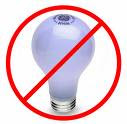 The European Union voted in October 2008 to ban outright incandescent light bulbs which transform a miserable 5% of the electricity into light. On Monday this week, they published the timing for the suppression of these inefficient incandescent bulbs over the next four years. Starting September 1st 2009, the sale of 100+ watt bulbs will be banned throughout Europe. Over the following two years, the 75W+ and 60W+ will go from European store shelves. And finally, as of September 1st 2012, all classic incandescent bulbs will disappear. Even poor performing halogen bulbs will be targeted (objective to eliminate these by 2016).
The European Union voted in October 2008 to ban outright incandescent light bulbs which transform a miserable 5% of the electricity into light. On Monday this week, they published the timing for the suppression of these inefficient incandescent bulbs over the next four years. Starting September 1st 2009, the sale of 100+ watt bulbs will be banned throughout Europe. Over the following two years, the 75W+ and 60W+ will go from European store shelves. And finally, as of September 1st 2012, all classic incandescent bulbs will disappear. Even poor performing halogen bulbs will be targeted (objective to eliminate these by 2016).
A couple of comments: Australia was the first country to vote the end of incandescent bulbs (an outright ban by 2010). The US Congress voted at the end of 2007 the ban of incandescent bulbs by the end of 2014. Europe has voted one year after the US to end these polluting bulbs two years before the US.
With regard to the European decision, they estimate that a household will save 50 euros per year by moving to the low consumption options. Taken in another light, so to speak, this could sound like a stimulus package for the economy? Le Figaro suggested that the savings for all Europe would amount to between 5 and 10 billion euros annually. Admittedly I don’t know the efficiency in the production of the compact fluorescent light bulbs (CFL) or other low consumption bulbs, but I am going to hope that the life cycle analysis shows that the halogen or the LED (Light Emitting Diode) is indeed a winner for the environment. Advocates argue that the CFL lasts five years longer and uses about 75 percent less energy than the incandescent bulb. From one article (Red, Green & Blue blog), I note that the 60% reduction in energy consumption would translate into a reduction of 30 million tonnes of CO2 for Europe. The LED option, whose sales have been increasing 40-60% per year, costs a lot more than the incandescent polluter, but the almost infinite durability and tremendous efficiency make a winning proposition as long as you don’t drop it along route from the store.
It is worth noting that, as detractors of this decision state, CFLs contain mercury. CFL’s are still a little bulkier and don’t fit all fixtures. For others, the European decision does not go far enough (e.g. Ban-the-Bulb). So, it may yet be hard to always look on the bright side of light. Nonetheless, I believe that such a decision will, among other things, continue to bring home the need to take action. Like “quota” systems (e.g. Norway’s women on corporate boards…), this law is perhaps anti-free market and will have its detractors. It will obviously change the landscape of the light bulb market (affecting electricians, lamp manufacturers and more). Nonetheless, there are justifiable impositions and, in this case (as in the case of the Norwegian quota) I cast my vote in favour. What about you?










